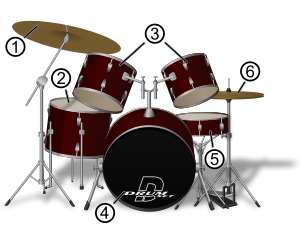No matter how many times the same points are brought up when it comes to common problems that arise for newer songwriters, they bear repeating as a kind of checklist to go through once you feel you’ve finished a song and you want to send it out there. Of course, a song can never really feel “finished” if you’re the type who likes to tweak a lot, but what I’m going to list here are more obvious problems that come up again and again when I’m listening to newer songwriters.

- Image via Wikipedia
1. INTRO TOO LONG – I’ve seen this brought up by many songwriting instructors or critiques again and again, but somehow it doesn’t seem to sink in for many writers. If you are pitching your songs to publishers or artists, you are going to lose them so quickly if your intro is long and self-indulgent. They want to get to the meat of it, so don’t serve so much salad! Keep your intro as short as you can, and you can even try no intro at all! Now of course, you’re going to find lots of examples of pro recordings out there with long intros, but these are often by artists or bands who have long since established some kind of following and they can get away with it. You can’t.
2. FILLER LYRICS – Even if you have one really good hook in your song, don’t ignore the rest of it! The sound of boring old phrases will put even the most enthusiastic of your listeners right to sleep. Your job is to take every one of those old, boring lines and make them remarkable. There is not one syllable’s worth of room for boring! Don’t get lazy or impatient, keep going over every line and make it better.
3. UNREMARKABLE MELODIES – in some cases the problem can be one of two things: either the melody is too repetitive, or it’s not repetitive enough! Work on your melodic phrasing, listen to popular songs or songs you like and notice how often the same melody is repeated within a verse and then within a chorus. The human brain can remember a sequence of up to 7 digits easily, then it starts to lose track. This is not to say you should only put 7 notes in your melodic phrasing, but just keep in mind that people who are listening to your songs fresh can only remember and retain so much. On the flip side if you keep throwing the same melody at them over and over, they’ll drift off to sleep. Too much or lack of repetition is probably the most common problem I hear in songwriter’s melodies.
4. POOR PERFORMANCE – if you’re not a singer, don’t sing on your own demos. For the purpose of getting a demo made, of course you’ll probably need to give them a rough version of the melody. The same goes for your accompaniment. If you can’t play very well, get somebody else to do it. A poor performance of even a great song will often be a distraction for those who are listening with a critical ear. Your mom will love it, your publisher won’t :-).
5. LACK OF A THEME AND CONTINUITY – what is your song about? If you can’t tell me in one phrase, then you haven’t got the chorus down yet. And don’t tell me it’s a love song, that’s going to lose me too! There are a gazillion love songs out there, what makes yours different? Then look at the continuity of your lyrics, is the first verse tied to the next one? Can you describe the “story” as it unfolds in each verse and does it make sense as a whole? A common problem is disjointed lyrics where one part of a song doesn’t seem to have anything to do with the next part and it’s difficult to really know what the song is about. It’s like walking into an extremely cluttered living room, where your eyes don’t know what to look at first. In a song with no continuity, your ears can’t figure out what to listen to either. Get rid of all the furniture and pictures, pare it down and start again!
The above problems are not insurmountable, and yet they will stand out immediately to someone who is used to listening to a lot of songs, like a publisher. You don’t want to give anyone the excuse to hit stop too soon! Take your time to fix them and it will pay off, I promise :-).
Happy 2011!
IJ
Related articles
- Diane Warren – The Queen of Hit Songwriting (kingsofar.com)
- So You Want My Job: Songwriter (artofmanliness.com)
- Stephin Merritt: Great songwriter, lousy interview (theglobeandmail.com)


